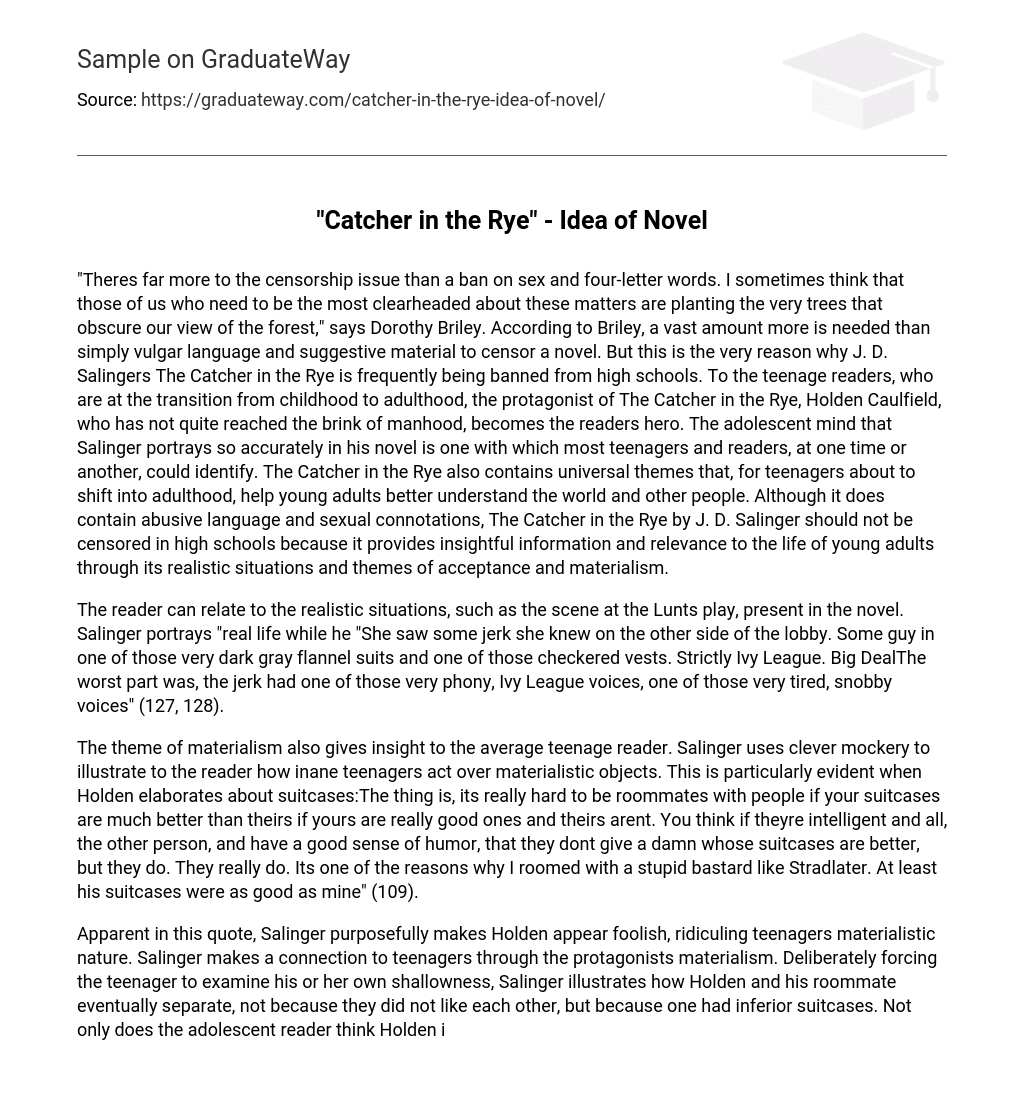According to Dorothy Briley, the issue of censorship goes beyond banning explicit content. She believes that those who are most knowledgeable about this matter often contribute to obscuring the bigger picture. The frequent prohibition of J.D. Salinger’s The Catcher in the Rye in high schools is primarily due to its offensive language and suggestive content. Nevertheless, these very elements resonate with teenage readers as they navigate their way from childhood to adulthood. Salinger effectively depicts the adolescent mindset, making it relatable for young adults and readers alike. Additionally, The Catcher in the Rye delves into universal themes that assist teenagers in gaining a better comprehension of both the world and human nature as they prepare for adulthood. Despite its explicit language and sexual references, The Catcher in the Rye by J.D. Salinger should not be censored in high schools because it provides valuable insights and relevance to young adults through realistic situations and themes such as acceptance and materialism.
The novel includes realistic situations, such as a scene at the Lunts play, that the reader can relate to. Salinger depicts “real life” as “she
In the novel, the theme of materialism also provides insight for teenage readers. Salinger cleverly mocks the absurd behavior of teenagers over material possessions. This is especially seen when Holden discusses suitcases. He believes that being roommates with people becomes difficult if your suitcases are superior to theirs. Even if they are intelligent and have a good sense of humor, they still care about whose suitcases are better. This is why Holden chooses to room with someone like Stradlater, who has suitcases as good as his own (109).
In this quote, Salinger intentionally portrays Holden as foolish, ridiculing teenagers’ materialistic nature. Salinger forms a connection to teenagers through the protagonist’s materialism, forcing them to reflect on their own shallowness. He showcases how Holden and his roommate drift apart not because of personal dislike, but due to one’s inferior suitcases. The adolescent reader not only views Holden asinine and absurd, but also recognizes their own callow and foolish desire for material possessions. The theme of materialism in The Catcher in the Rye allows teenagers to understand the pointlessness of their materialistic needs, an essential concept during their transition to adulthood.
The theme of acceptance is portrayed by Salinger in the novel through Holden’s frequent reflections on his place in society and feelings of isolation. These emotions lead him to distance himself from friends and family. However, towards the end of the story, Holden realizes that he does need people who can understand him. He admits missing everyone he shared his thoughts with, including old acquaintances like Stradlater and Ackley. This resonates with teenagers who may also feel isolated and unhappy. On the contrary, some young adults conform to societal norms out of fear of loneliness. Through Holden’s actions and reactions to society, he becomes a hero for readers, highlighting the theme of acceptance throughout the book. Although speaking his mind is valued by teenage readers, it often results in social exclusion. Conversely, when Holden conforms to societal expectations, he experiences a sense of acceptance from his peers.
PLACE SALLY QUOTE HERE. When Holden speaks his mind honestly, he feels isolated and awkward.PLACE QUOTE WHEN HE TELLS SALLY HIS DREAMS HERE.
The protagonist’s perspective in J. D. Salinger’s The Catcher in the Rye provides a glimpse into the advantages and disadvantages of defying or adhering to societal expectations. This novel explores the theme of acceptance, urging teenagers to critically evaluate society’s beliefs while emphasizing the importance of companionship and family. These ideas play a crucial role in shaping readers’ transition into adulthood.





